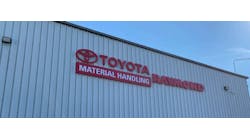Americans love ice cream. And, they love it more each year. Companies produced more than 1.5 billion gallons of ice cream and frozen desserts over the last 10 years, according to the U.S. Department of Agriculture.
This high demand led Ben & Jerry’s, manufacturer of popular, quirky ice-cream flavors like Cherry Garcia and Phish Food, to reassess its operations. Specifically, Ben & Jerry’s needed to improve uptime and reduce maintenance costs in its manufacturing and distribution site in St. Albans, Vt.
The Epicenter
Ben & Jerry’s has more than 650 employees in three facilities, all in Vermont—
South Burlington, Waterbury and St. Albans. Corporate offices are located at the South Burlington site. The Waterbury facility exclusively produces Ben & Jerry’s own two lines and is the top tourist destination in Vermont, attracting more than 300,000 people each year.
The 143,000-square foot St. Albans facility is the primary manufacturing site, not only for Ben & Jerry’s ice cream, but also for two other brands: Breyers and Good Humor.
St. Albans produces more than 200 flavors of ice cream, 24 hours a day, five days a week, starting at 9 p.m. each Sunday night and ending at 11 p.m. every Friday. Across four manufacturing lines, the company produces nearly 1,700 pallets of product per week, all of which are stored and handled several times before eventually being distributed from the facility. Raw ingredient and packaging moves add another 4,000 pallet touches per week.
“Because of the volume of inventory that comes in and goes out on a daily basis, it is literally impossible to be successful without dependable trucks,” says Mark Favreau, logistics manager for the St. Albans facility.
In 2003, Ben & Jerry’s added a new distribution center—a 2,000-pallet freezer where all of the ice
cream produced by the St. Albans and Waterbury facilities would be stored and distributed. The Ben & Jerry’s distribution center in Bellow Falls, Vt., closed in 2004, making the St. Albans facility the epicenter for manufacturing, storing and distributing Ben & Jerry’s ice cream worldwide.
Fresh Challenges
With the new distribution center came new material handling challenges. Since the freezer was built to store all of the ice cream from both the Waterbury and St. Albans facilities, it was designed with high, double-deep racking to maximize storage space and is kept at -20°F at all times.
The three areas that lift trucks must pass through each present its own challenges. The first section of the building, containing the 2,000-pallet freezer, is the storage and distribution area. The frigid temperatures are unkind to equipment, and the racking is more than 33 feet high and doubledeep, requiring skilled lift truck operators. A second area, where the ice cream is manufactured, is kept at 38°F to 40°F. In this area, it is common for lift trucks to be driven through water or icecream residue on the production floor. The final area of the facility is a room-temperature, dry-goods warehouse, which stores plastic tubs, cardboard, dry powdered goods, yogurt cultures and stabilizers. Like the freezer area, the dry-goods warehouse also has high racking.
As trucks pass into and out of the production area, door foamers sanitize the tires. “The door foamers are very good at eliminating bacteria and germs on equipment and shoes; however, they can wear down wheels and bearings, too,” Favreau says. “From Sunday through Friday night, the trucks are moving nonstop in and out of freezers, through water in the production room and through disinfectant foamers, so the environment plays a huge role in equipment wear and tear.”
However, the environmental challenges were not the only material handling difficulties Ben & Jerry’s would have to overcome. According to Favreau, there are approximately 4,500 pallet spaces in the St. Albans facility, and with the rapid pace with which inventory flows in and out, downtime is unacceptable.
“We had four lift trucks and two single pallet trucks on a five-year lease, and those trucks were down 60% of the time,” Favreau says.
Sweet Solution
Ben & Jerry’s called on Pengate Handling Systems Inc. (Syracuse, N.Y.), a dealer for Raymond Corporat i
on, to recreate its existing lift truck fleet. Pengate recommended three Raymond Deep-Reach electric lift trucks, outfitted with cold-storage condi t ioning pa ckages and ThermaKit systems that warm the control handle and floor pad for operator comfort. Over time, two EASi Pacer stand-up counterbalanced trucks and two model 8400 pallet trucks were added to the fleet.
With the exception of the Deep- Reach trucks in the freezer, all of the powered vehicles, including the EASi Pacer and model 8400 pallet trucks, transition easily among the different areas of the facility.
In addition, Pengate worked with Ben & Jerry’s to implement a comprehensive, fixed-price maintenance agreement (CFPM) to ensure increased uptime.
According to Favreau, virtually every one of the 22 Raymond lift trucks the facility owns or leases has a CFPM. Ben & Jerry’s pays a flat fee per month for all maintenance costs (outside of operator-induced damage) for the life of a lift truck’s contract. Under the flat-fee structure, most damage to the lift trucks is covered, and according to Favreau, Pengate goes above and beyond to ensure the lift trucks are operating properly.
“I do not have enough good things to say about Pengate,” he says. “It has been fantastic. The maintenance guys are in here regularly checking on the equipment. If they have not heard from us, they even stop in. Pengate is instrumental in maintaining uptime.”
The lift trucks and the CFPM ultimately resulted in a 60% reduction in downtime and 35% decrease in repair costs. Equally significant have been productivity improvements, as more pallets of ice cream can now be stocked, stored and shipped each day.
“We used to run a two-shift operation, but in 2003, when we started working with Pengate, we began to run 24 hours a day,” says Favreau. “Then, in 2005, for nearly nine months of the year, we ran our operations six and seven days a week, and Raymond and Pengate have been instrumental in allowing us to do that.”



